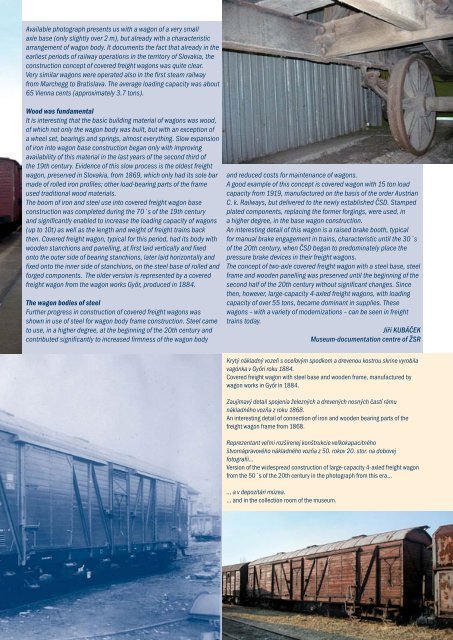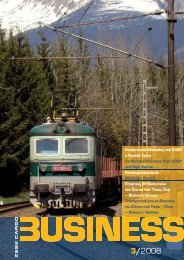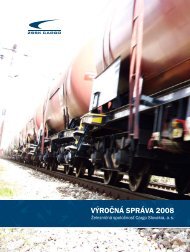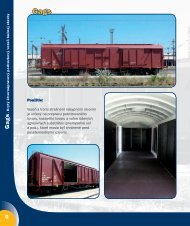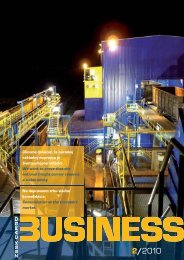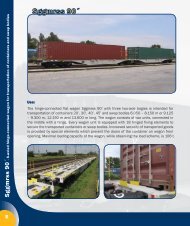CARGO BUSINESS 3-09.indd - ZSSK Cargo
CARGO BUSINESS 3-09.indd - ZSSK Cargo
CARGO BUSINESS 3-09.indd - ZSSK Cargo
Create successful ePaper yourself
Turn your PDF publications into a flip-book with our unique Google optimized e-Paper software.
Available photograph presents us with a wagon of a very small<br />
axle base (only slightly over 2 m), but already with a characteristic<br />
arrangement of wagon body. It documents the fact that already in the<br />
earliest periods of railway operations in the territory of Slovakia, the<br />
construction concept of covered freight wagons was quite clear.<br />
Very similar wagons were operated also in the first steam railway<br />
from Marchegg to Bratislava. The average loading capacity was about<br />
65 Vienna cents (approximately 3.7 tons).<br />
Wood was fundamental<br />
It is interesting that the basic building material of wagons was wood,<br />
of which not only the wagon body was built, but with an exception of<br />
a wheel set, bearings and springs, almost everything. Slow expansion<br />
of iron into wagon base construction began only with improving<br />
availability of this material in the last years of the second third of<br />
the 19th century. Evidence of this slow process is the oldest freight<br />
wagon, preserved in Slovakia, from 1869, which only had its sole bar<br />
made of rolled iron profiles; other load-bearing parts of the frame<br />
used traditional wood materials.<br />
The boom of iron and steel use into covered freight wagon base<br />
construction was completed during the 70´s of the 19th century<br />
and significantly enabled to increase the loading capacity of wagons<br />
(up to 10t) as well as the length and weight of freight trains back<br />
then. Covered freight wagon, typical for this period, had its body with<br />
wooden stanchions and panelling, at first laid vertically and fixed<br />
onto the outer side of bearing stanchions, later laid horizontally and<br />
fixed onto the inner side of stanchions, on the steel base of rolled and<br />
forged components. The older version is represented by a covered<br />
freight wagon from the wagon works Győr, produced in 1884.<br />
The wagon bodies of steel<br />
Further progress in construction of covered freight wagons was<br />
shown in use of steel for wagon body frame construction. Steel came<br />
to use, in a higher degree, at the beginning of the 20th century and<br />
contributed significantly to increased firmness of the wagon body<br />
and reduced costs for maintenance of wagons.<br />
A good example of this concept is covered wagon with 15 ton load<br />
capacity from 1919, manufactured on the basis of the order Austrian<br />
C. k. Railways, but delivered to the newly established ČSD. Stamped<br />
plated components, replacing the former forgings, were used, in<br />
a higher degree, in the base wagon construction.<br />
An interesting detail of this wagon is a raised brake booth, typical<br />
for manual brake engagement in trains, characteristic until the 30´s<br />
of the 20th century, when ČSD began to predominately place the<br />
pressure brake devices in their freight wagons.<br />
The concept of two-axle covered freight wagon with a steel base, steel<br />
frame and wooden panelling was preserved until the beginning of the<br />
second half of the 20th century without significant changes. Since<br />
then, however, large-capacity 4-axled freight wagons, with loading<br />
capacity of over 55 tons, became dominant in supplies. These<br />
wagons – with a variety of modernizations – can be seen in freight<br />
trains today.<br />
Jiří KUBÁČEK<br />
Museum-documentation centre of ŽSR<br />
Krytý nákladný vozeň s oceľovým spodkom a drevenou kostrou skrine vyrobila<br />
vagónka v Győri roku 1884.<br />
Covered freight wagon with steel base and wooden frame, manufactured by<br />
wagon works in Győr in 1884.<br />
Zaujímavý detail spojenia železných a drevených nosných častí rámu<br />
nákladného vozňa z roku 1868.<br />
An interesting detail of connection of iron and wooden bearing parts of the<br />
freight wagon frame from 1868.<br />
Reprezentant veľmi rozšírenej konštrukcie veľkokapacitného<br />
štvornápravového nákladného vozňa z 50. rokov 20. stor. na dobovej<br />
fotografii...<br />
Version of the widespread construction of large-capacity 4-axled freight wagon<br />
from the 50´s of the 20th century in the photograph from this era...<br />
... a v depozitári múzea.<br />
... and in the collection room of the museum.


